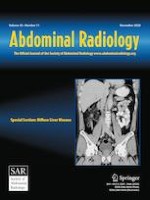Erschienen in:

26.05.2020 | Hollow Organ GI
Assessment of pediatric Crohn’s disease activity: validation of the magnetic resonance enterography global score (MEGS) against endoscopic activity score (SES-CD)
verfasst von:
Xianying Zheng, Meina Li, Yinchen Wu, Xuehua Lin, Zhongshuai Zhang, Weiwei Zheng, Mi Wang
Erschienen in:
Abdominal Radiology
|
Ausgabe 11/2020
Einloggen, um Zugang zu erhalten
Abstract
Objective
The aim of this study is to evaluate the ability of magnetic resonance enterography global score (MEGS) to diagnose the activity of pediatric Crohn’s disease (CD) and its correlation with endoscopic activity score.
Materials and methods
70 pediatric CD patients (between the ages of 6 and 17) were enrolled who underwent ileocolonoscopy and magnetic resonance enterography (MRE) within 7 days. The simplified endoscopic activity score for Crohn’s disease (SES-CD) and MEGS were acquired in the terminal ileum. Sensitivity and specificity of MEGS for detection disease activity against SES-CD was compared using the McNemar test. The correlation between MEGS and SES-CD was assessed by Spearman's rank estimation. The diagnostic accuracy of MEGS for active disease defined by SES-CD was calculated. Receiver operating characteristic curves (ROC) were constructed.
Results
Fifty-two pediatric CD patients (median age, 12 years old; 28 girls, 24 boys) were included. The incidence of upper gastrointestinal (GI) tract (23%) involvement and perianal lesions (42%) is high in pediatric Crohn’s patients, and most of them suffer from internal hemorrhoids (86.5%). MEGS showed strong correlation to SES-CD (r = 0.70, P < 0.001). With endoscopic as the standard of reference, the MEGS had a high accuracy for the detection of inflammation (area under the ROC curve (AUC) of 0.89, sensitivity 0.95 and specificity 0.82) and for disease activity (AUC of 0.81, sensitivity 0.88 and specificity 0.75) in the terminal ileum.
Conclusion
Pediatric Crohn’s disease is unique. Our study has shown a good correlation between MEGS and endoscopy activity score with equal diagnostic efficacy. MEGS is a promising method to assess disease activity and perhaps be a valuable tool in following therapeutic changes.











